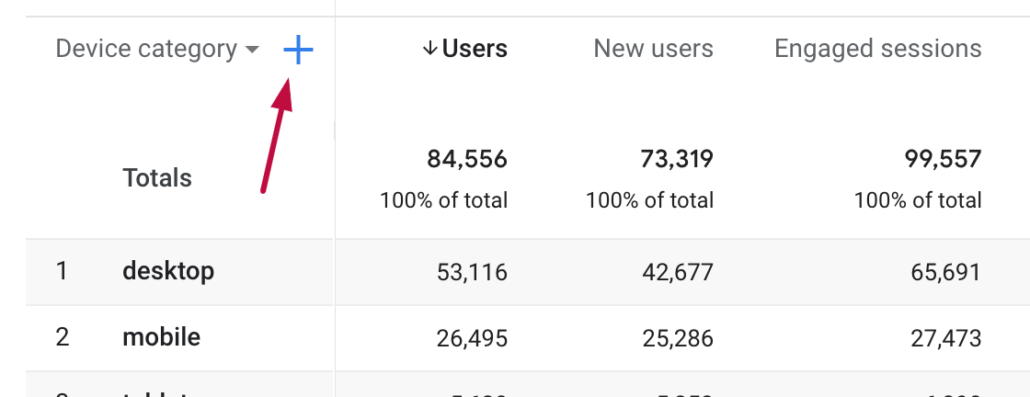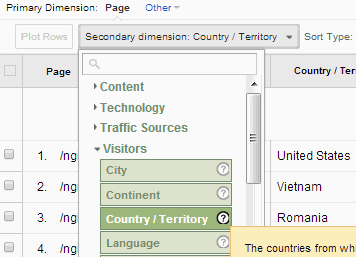Just How to Use Secondary Dimension in Google Analytics for Deeper Insights
Just How to Use Secondary Dimension in Google Analytics for Deeper Insights
Blog Article
Gain Thorough Point Of Views With Secondary Measurement in Google Analytics
Second measurements in Google Analytics act as an effective device for enhancing the depth of insights obtained from information evaluation. Remain tuned to discover just how additional dimensions can reinvent your data analysis and drive notified decision-making in the electronic realm.
Understanding Additional Measurements in GA
The principle of additional dimensions in Google Analytics improves data evaluation by giving added insights into main metrics. Secondary measurements enable users to dive deeper right into their data by adding an additional layer of details to the main data being analyzed. By including second dimensions, customers can segment and contrast data throughout different dimensions, such as traffic resources, user devices, geographical places, and extra. This additional level of granularity makes it possible for an extra extensive understanding of customer behavior and web site efficiency.
Understanding exactly how to effectively make use of secondary dimensions in Google Analytics is crucial for removing valuable insights from the information collected. By selecting the appropriate secondary dimensions to complement key metrics, users can reveal patterns, trends, and relationships that may have or else gone undetected. This much deeper degree of analysis can bring about even more enlightened decision-making and the optimization of electronic advertising and marketing techniques to boost overall performance.
Advantages of Utilizing Additional Measurements
Discovering the benefits intrinsic in leveraging second measurements within Google Analytics brightens the depth of insights offered for boosting information analysis. By incorporating secondary measurements, individuals can get an extra thorough understanding of their primary data metrics.
In addition, second measurements allow individuals to contrast and contrast various data points within the very same report, giving a more all natural view of web site efficiency. This comparative evaluation can clarify the efficiency of advertising and marketing projects, material interaction, or customer demographics. In addition, making use of additional measurements can help in identifying outliers or abnormalities that might call for additional investigation.
Essentially, leveraging second measurements in Google Analytics offers an effective device for drawing out important insights and maximizing data-driven decision-making procedures.
Carrying Out Secondary Measurements Efficiently
To properly execute secondary dimensions in Google Analytics, planning the option and application of these added data layers is extremely important for making the most of the depth of understandings derived from analytics reports. When selecting second dimensions, consider the particular objectives of your analysis to make certain the picked dimensions line up with the info needed to answer relevant concerns. It's necessary to prioritize relevance over quantity, picking dimensions that enhance the key measurement and offer meaningful context.
Furthermore, understanding the connection in between the second and main measurements is critical. This comprehension allows you to analyze the data accurately and draw workable final thoughts. Executing second measurements efficiently involves utilizing them to uncover patterns, fads, and connections that may not be noticeable when assessing information solely based upon the primary measurement. By incorporating additional measurements attentively, you can boost the granularity of your evaluation and gain deeper insights right into user behavior, material performance, and other crucial metrics within Google Analytics.
Analyzing Data With Secondary Measurements
Utilizing secondary measurements in information evaluation gives a nuanced perspective that uncovers complex connections and more information patterns within Google Analytics records. By including secondary measurements together with main dimensions, analysts can delve deeper into the data to extract useful understandings. This approach makes it possible for the identification of correlations that might not be right away evident when analyzing data entirely based on main measurements.
When assessing information with secondary dimensions in Google Analytics, it is necessary to take into consideration the particular metrics or measurements that will certainly supply the most significant context for the primary dimension being analyzed. For example, matching the key dimension of 'website traffic resource' with additional measurements such as 'device category' or 'landing web page' can supply an extra comprehensive understanding of customer behavior and preferences.
Moreover, the capacity to segment information utilizing secondary measurements permits for an extra granular evaluation of individual interactions, assisting in the optimization of advertising and marketing methods, internet site performance, and overall user experience. By leveraging second dimensions effectively, businesses can make enlightened choices based upon a comprehensive analysis of their Google Analytics information.
Ideal Practices for Second Measurements
When implementing second dimensions in Google Analytics, accuracy in picking appropriate metrics is extremely important for deriving actionable insights from the information analysis process. One of the most effective methods for using secondary measurements efficiently is to align them with your primary measurement to obtain a more detailed understanding of your site or project performance. For instance, if your primary dimension is 'Source/Medium,' coupling it with secondary dimensions like 'Tool Classification' or 'Touchdown Page' can provide insights right into just how various devices or landing pages impact traffic from various resources.

Frequently trying out various mixes of secondary and primary dimensions can aid you uncover new connections and patterns within your data, enabling you to optimize your methods and boost overall efficiency (Secondary Dimension in Google Analytics). By complying with these ideal practices, you can utilize additional measurements in Google Analytics properly to gain deeper understandings and make data-driven decisions that positively impact your company

Verdict
In conclusion, second dimensions in Google web link Analytics provide a beneficial possibility to acquire deeper insights into primary data metrics. By including a secondary dimension to records, organizations can reveal correlations, fads, and patterns that may not be promptly apparent, leading to a much more thorough understanding of customer habits and communications on a website. Implementing second measurements successfully and assessing information with them can assist organizations make data-driven choices and optimize their on-line efficiency.
By including additional dimensions, users can section and contrast information throughout various dimensions, such as web traffic resources, individual devices, geographic locations, and a lot more. Executing additional dimensions properly view it now includes utilizing them to uncover patterns, fads, and connections that might not be noticeable when assessing information entirely based on the key measurement. By incorporating additional dimensions along with primary dimensions, experts can dive much deeper into the information to remove valuable insights. One of the finest techniques for making use of secondary dimensions successfully is to align them with your primary measurement to gain a more detailed understanding of your website or project efficiency. If your primary measurement is 'Source/Medium,' coupling it with secondary dimensions like 'Gadget Classification' or 'Touchdown Page' can supply understandings into just how various gadgets or touchdown web pages impact web traffic from different sources.
Report this page